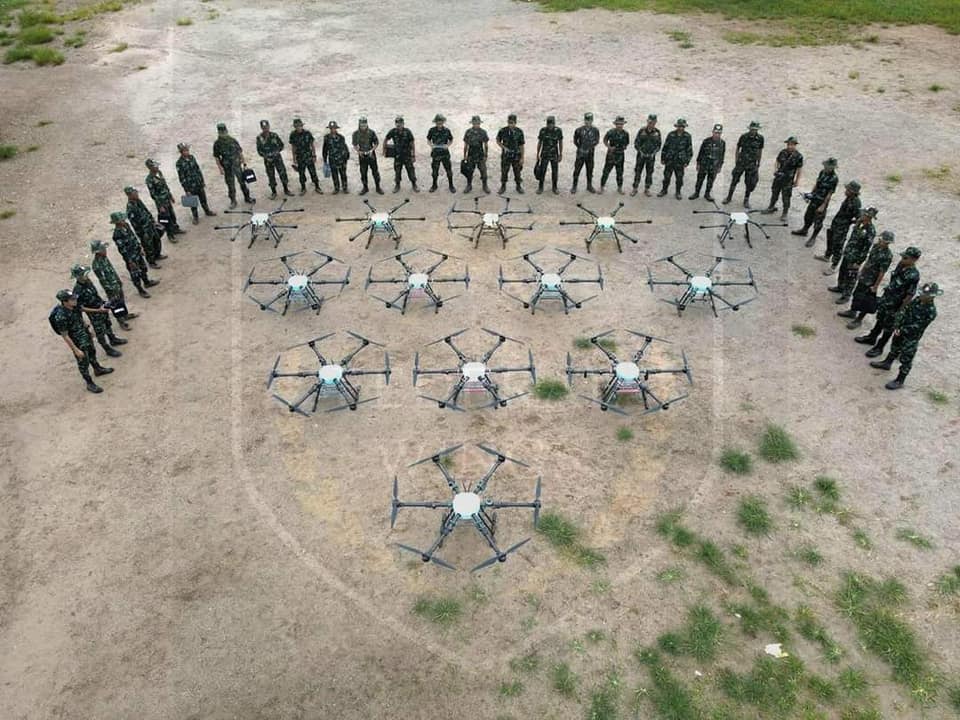Resistance drone attacks taking a toll

The Myanmar military regime is installing anti-drone guns at important buildings and places, junta spokesman Major General Zaw Min Tun said at the regime’s regular press conference on Tuesday, an indication that the resistance’s drone warfare against the regime is working effectively.
A little over a year ago, when resistance fighters collectively known as the People’s Defense Force started fighting back against the regime, they were armed only with homemade guns and rudimentary hunting rifles. Today, many resistance groups are employing drones to bomb military targets on both land and water.
At the 16th ASEAN Ministerial Meeting on Transnational Crime on Thursday, the junta’s deputy home affairs minister and police chief, Major General Zin Min Htet, admitted that PDF groups are using improvised explosives and drones to create ever more powerful explosions.
Drones are among the weapons the junta’s frontline troops most fear, as they can inflict damage on a wide area beyond the specific target, according to defectors. PDFs are also using drones against junta ground assault troops in Karen State and Sagaing Region. Five regime soldiers were killed in a resistance drone attack in Karen State on Wednesday.
Nuclear ambitions reaffirmed

With the Myanmar military regime increasingly pursuing nuclear technology with help from Russia, junta spokesman Maj-Gen Zaw Min Tun confirmed at Tuesday’s press briefing the regime’s plan to implement a small nuclear power plant project in the next few years.
Without specifying where the reactor will be built, he said the Atomic Energy Department of the junta-controlled Ministry of Science and Technology will establish a “nuclear information technology center” in Yangon, which will be assigned to gauge and influence public opinion on nuclear energy.
Myanmar’s bid to acquire nuclear technology dates back to the time of former military dictator Than Shwe, who also sought to build a nuclear research center with the help of Russia. The latest plan for a nuclear power plant follows the regime’s recent signing of a nuclear roadmap agreement with Russian state-owned nuclear agency Rosatom on further atomic energy cooperation including the possible implementation of a modular reactor project in Myanmar.
Though the regime says nuclear energy would be used for peaceful purposes in Myanmar, which has been hit by chronic electricity shortages, many believe it is just an initial step in a plan to utilize nuclear energy for military purposes including production of nuclear weapons.
Threats fall on deaf ears

Speaking at the same press conference, Maj-Gen Zaw Min Tun threatened supporters of the parallel National Unity Government (NUG) with charges punishable by death.
Those who donate even a penny to the NUG, its parliamentary wing the Committee Representing Pyidaungsu Hluttaw (CRPH), or its armed wing the People’s Defense Force (PDF) could face the death penalty, the junta spokesman warned, adding that netizens who like and share Facebook posts of the NUG and its affiliates faced charges carrying up to 10 years in prison.
The military junta has labeled the NUG, CRPH and PDF as terrorist organizations, and junta-controlled newspapers have featured reports on the theme of “identifying and taking legal action against those who support the NUG and its affiliates” since January. Nearly 100 people have been prosecuted under the Counterterrorism Law, Penal Code and Electronic Transactions Law for their alleged ties to the groups.
To see whether such threats are having the desired effect, one need look no further than the arsenals of the PDF groups. Initially armed with homemade rifles when they formed last year, many of the groups are now equipped with automatic assault rifles. Some are better dressed than the regime’s forces and many are well fed by supporters at home and abroad. To the regime’s dismay, a recent raffle of a wood panel created by detained State Counselor Daw Aung San Suu Kyi’s son raised more than US$1.7 million in less than two weeks to help the Myanmar people fight the regime. The amount exceeds the $1.3 million Daw Aung San Suu Kyi received for winning the Nobel Peace Prize in 1991.
Junta can’t confirm or deny Buckingham Palace haunted

Contrary to what you might have heard, the junta’s information team is actually quite responsive! Especially when you ask for confirmation of something ridiculous, like whether or not Buckingham Palace is haunted by the ghost of Queen Elizabeth II!
A recent leaked screenshot, viewed by The Irrawaddy, from the regime’s “Information Team” closed group on Viber, offers ample evidence. The group was formed by the team for sharing information and has 130 participants, mostly from pro-regime media. The team is led by the regime’s deputy information minister, who is known for his unprofessionalism and reckless comments.
Following the funeral of the Queen, a so-called journalist from pro-junta media outlet Myanmar Hard Talk (MHT) told the team he had learned that her soul had yet to rest in peace and that Buckingham Palace was haunted. (Sorry… he didn’t say how he got the scoop!) Then he asked:
“I was informed that the palace is arranging to invite some monks from Myanmar for a recitation of Buddhist mantras to help the Queen’s soul rest in peace. Have they invited the monks? Thanks!”

The regime’s information team treated this absurd inquiry quite seriously, replying—apparently without irony—just over an hour later: “The Ministry of Religious Affairs and Culture hasn’t received any invitation yet.”
The question by MHT is a classic example of the efforts of pro-junta media in Myanmar to propagate misinformation and disinformation in the country. But why drag the Queen into it? It’s simple: the Myanmar regime was among a handful not invited to attend the funeral. So the junta lobbyist tried to circulate some fake news attacking the Queen and Britain. If nothing else, the episode sheds light (as if any were needed) on just how lacking in intelligence the people working for pro-regime media in Myanmar truly are.

















